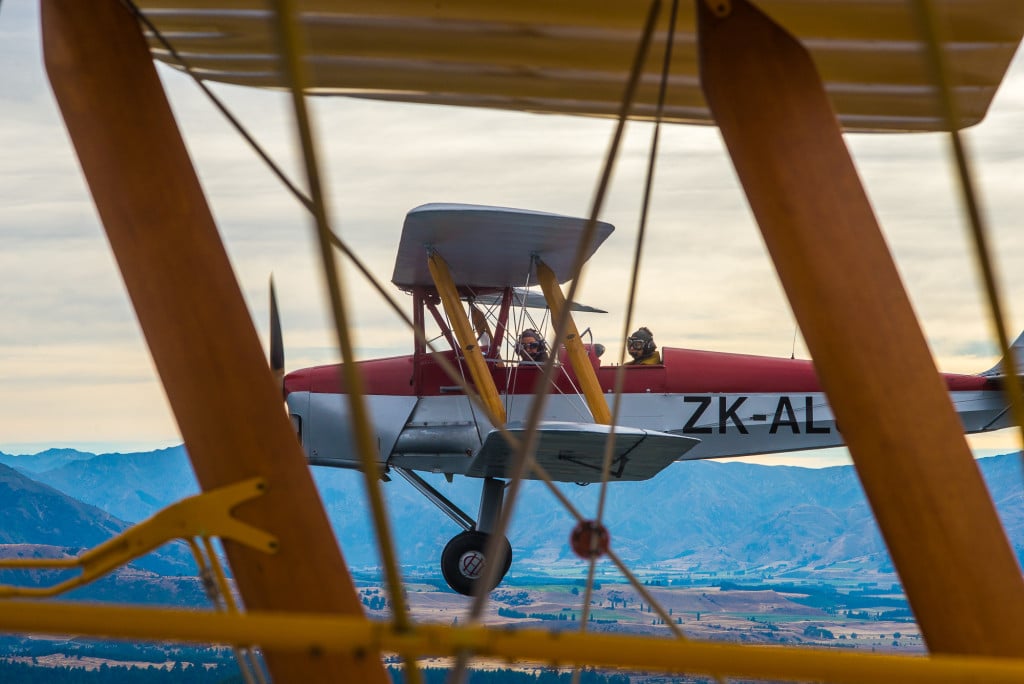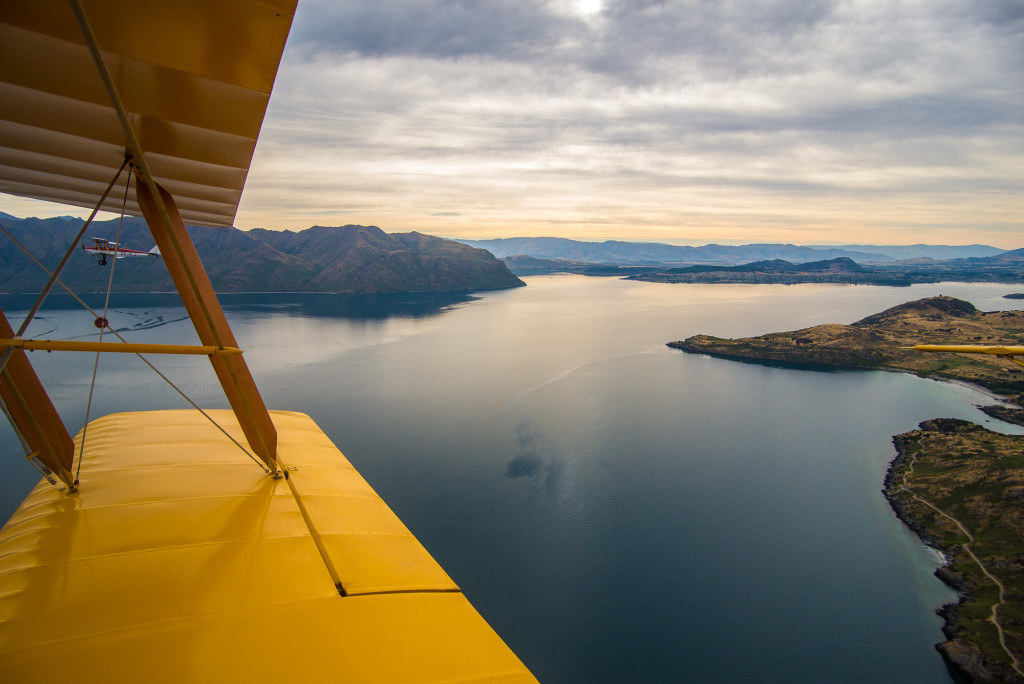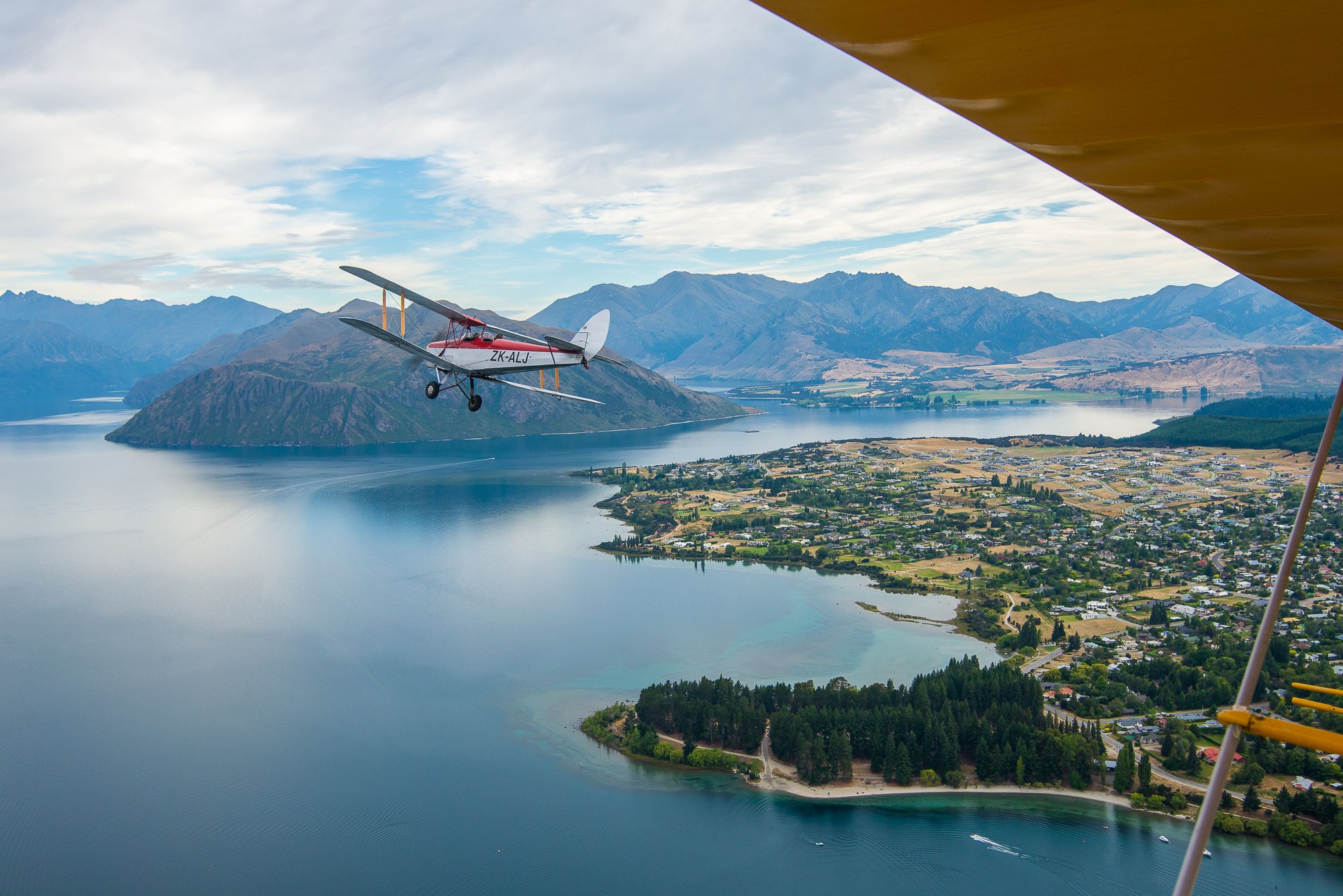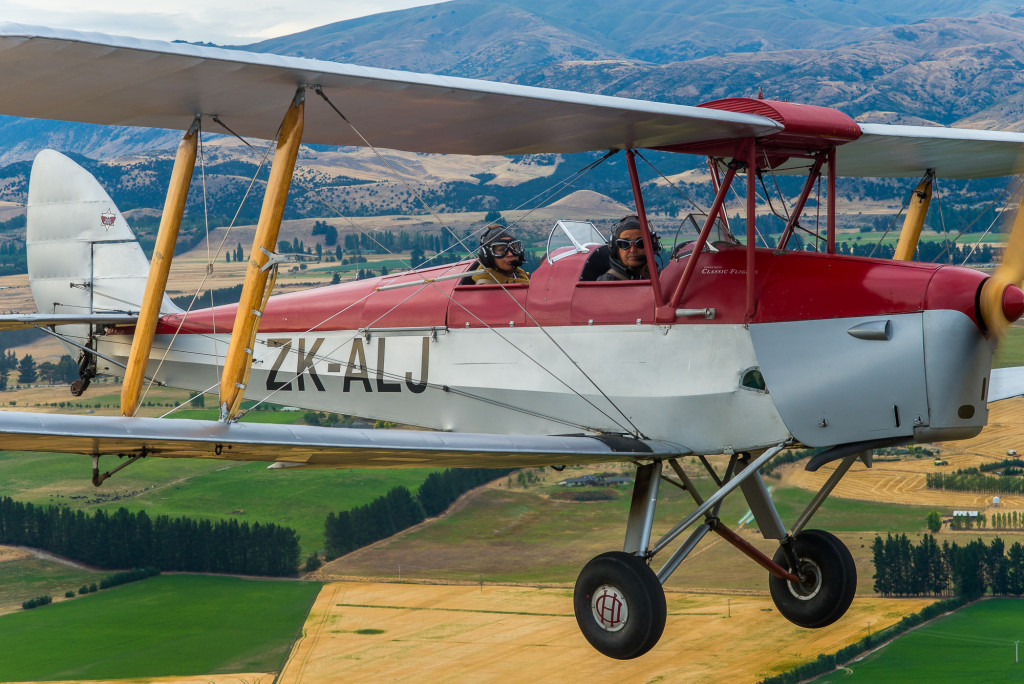Tucked tightly into a leather flying helmet, firmly held down by H.G. Wells inspired aviator goggles, my hair should have been standing decidedly on end at this moment. Thick leather straps pinioned me to the seat and my shivering limbs had nothing to do with the cool autumn breeze. “How’re you feeling? You ok?” His face nipped in and out of my field of vision as he busied himself with buckles, buttons, and the huge prop up front. “Yeah, I’m good,” my reply sounded less ‘good’, more ‘unhinged’. He laughed. “You’ll love it!”
He was right, of course. I loved it. Every heart-pounding, nerve-tingling, breath-robbing moment of my first flying lesson was out of this world miraculous.
Let me go back to the beginning, set the scene for you. I am an adrenaline junkie by design. I was not born for adventure – I crave it, despite intense fears and anxiety. If someone was cooking up an antic Dangermouse would raise his eyebrow at, I was in, even though on the inside I would be simultaneously having a mental breakdown and a hiatal hernia. For some unknown and inexplicable reason I say YES to adventure, every time, without fail, even though my brain is exasperatedly throwing in the towel and resigning again.
Fear of heights? Easy. Get a job as a jump master for AJ Hackett in adventure-mad New Zealand. Fear of flying? Ha! Have I got the cure for you! Learn to fly in a 1940’s WW2 vintage biplane. Now we’re talking! When I told Peter Hendricks from Learn to Fly in Wanaka, New Zealand, I wanted to learn to fly, he immediately suggested learning in the Tiger Moth. Why? Because everyone who knows me knows I love to push the envelope. Ever wonder why all the best superheroes wear a mask? It’s not to hide their identity so much, although it helps. It’s to hide their fear.
Fear, neatly, professionally and irrevocably hidden from view, I said a resounding, “YES!”
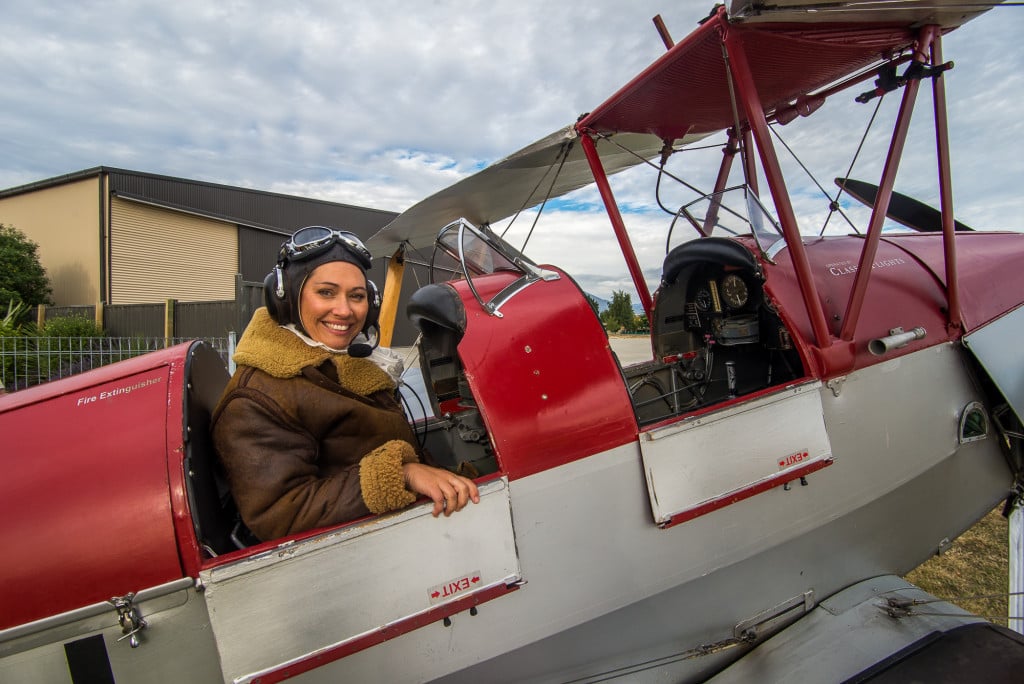
It was not my first time in a plane. It was not even my first time in a Tiger Moth. I love old planes, especially the Tigers. I’ve had a bit of a love affair with them since first seeing The English Patient on the big screen. The scene of the Count and Kathrine Clifton flying over the Tunisian desert haunted me passionately for years. When I moved to Wanaka and discovered there was a company offering Tiger Moth sightseeing flights, I was, well, let’s just say pretty excited. (Gibberishly excited, literally bouncing-up-and-down-like-a-five-year-old-in-a-lolly-shop-with-a-fistful-of-cash excited.) So, of course, I signed myself up for a flight. A thirty-minute scenic flight over the stunning Lake Wanaka, quaintly quirky lakefront township, epic mountains, and up the mighty Clutha River of the Lake Wanaka region had me laughing out loud, crying into my silk scarf, and convinced this was the best adventure of my many yet.
Once we touched down, parked up, disembarked, and I had hugged the Tiger Moth as well as you can hug an aircraft, I told Peter Hendricks that I was going to learn to fly. To my everlasting gratitude and gut-wrenching panic, this is how it all began.
Autumn is one of the best seasons for many things in the Lake Wanaka region and flying is undoubtedly one of them. Calm, clear days, perfect temperatures, not too hot and not too cold, vivid sunrises and sunsets, and views that include golden swathes of lake and riverside trees, make autumn here a photographers dream. Calm, clear days with little to no wind also makes autumn an aviators dream. This made me happy. My first flight was scheduled for a very calm, very clear, very perfect day – my dream conditions!
I approached ALJ with the kind of respectful admiration one would approach Jean Batten. “We’re going to fly together, you and I,” I told her as I trailed my fingers across her fabric wing. I should mention here that ALJ is her call sign – the last three of the painted numbers on her fuselage. She’s a rare beauty, ALJ is, with a mind of her own, and the resilience of a war-widow. She’s a moxie-licious darling of her era and I fell in love with her in the midst of a spiral nose dive toward the cerulean waters of Lake Wanaka. Aircraft, being in my mind a little like horses, should be charmed before you fly them. They have unique personalities. And ALJ has personality plus. So we had our wee girls chat before I headed to the dressing room to gear up. I agreed to look the part and go easy on her, and she promised me a smooth flight with no nonsense. We were going to get along just fine.
You don’t learn to fly a Tiger Moth in jeans. Oh, dear me, no. You wear a vintage aviator jumpsuit, a thick blanket of a sheepskin and leather bomber jacket and an authentic leather helmet with accompanying goggles. And if you’ve got a red lippy handy, by all means rock it baby. Once I was suitably attired Pete led me to the cockpit. Of course, being the greenhorn I am, I went for the front cockpit as in my scenic flight. “No, Carla, you’ll be flying this time. It’s the back seat for you.”
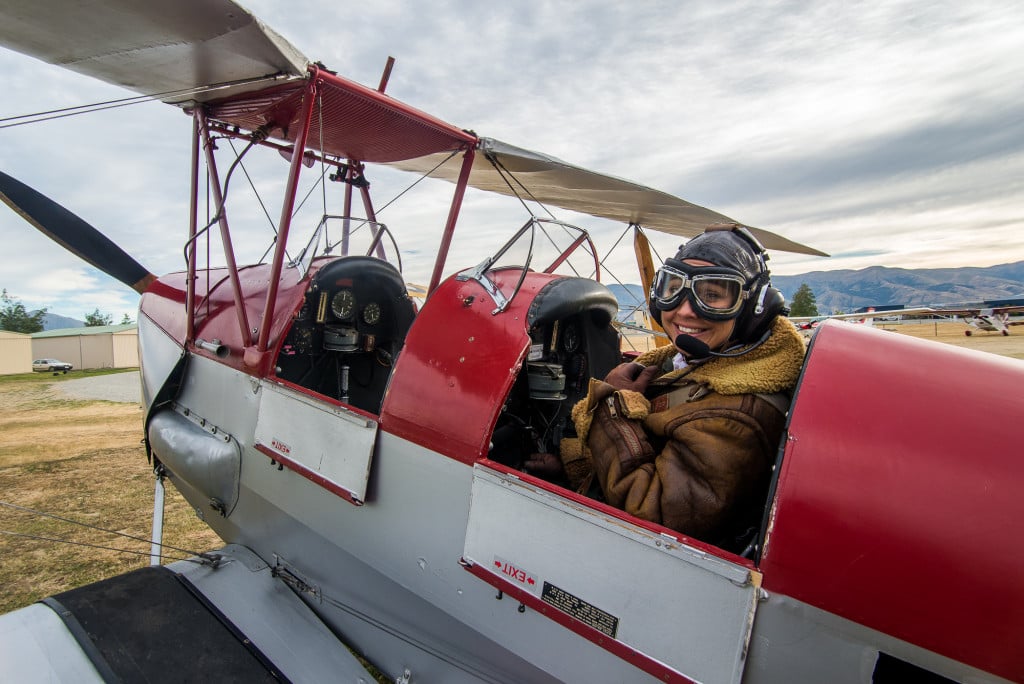
I would wear this to the coffee shop every day if it were socially acceptable.
Talk about back seat driving! Or flying, whatever, you get the picture. Tiger Moths have two small cockpits. They have been used as training craft since their beginnings in the 1930’s. Because of their need for a steady, firm hand Tiger Moths were the preferred training planes by instructors who wanted to weed out inept students. Both cockpits have full controls so either can fly the plane, but in training cases the instructor sits in the front, the student in the back. For scenic flights the passenger sits in front, while the pilot flies from the rear cockpit. So this was really it. Here I was, strapped up in the back seat, the chair of command, the pilot’s place. I was about to fly.
Is it weird to have one of the scariest, and one of the most exciting things about my first flight, was talking to Pete on the radio? Flick the lever down – speak – flick back to neutral, crackle in the headset as Pete instructed me to gently but firmly take hold of the stick. You see, you can’t see your instructor in a Tiger. You can only hear him. And you can only hear him through the static muffle of an aviation headset, which to my overactive imagination felt like being instructed by ghosts –the ghosts of the pilots who flew ALJ in the Great War. Her history seeped into my bones as Pete instructed me to rest both feet lightly on the rudder bars, ready to turn the craft left or right as required as we taxied onto the runway. Oh, another thing about Tiger Moths – no brakes. So making our way to the runway consisted of several, well-executed (I thought), wide turns to keep speeds down.
Once manoeuvred into position on the runway, Pete made the radio call and we were clear for take-off. It all sounds so civilised. Yes, that’s lovely, Alpha-Lemur-Juliette at a heading of blah blah blah, tracking west, a bunch of landmarks even I don’t know the name of, when really what was happening in the pilot seat was tantamount to jelly melting in the sun. A quivering, sweating mess. Excited? You betcha! Terrified? Oh all things, holy yes! No stranger to adrenaline, and definitely with a love of flying, particularly a love of flying in these graceful angels of the sky, I still believe this was one of the most brilliantly extreme things I’ve ever done. It’s all good and well to jump off bridges tied to a rubber band – my trust in karabiners and bungy cords are categorically logical. Skydiving, same thing – it’s all about the experience of your instructor and the meticulous condition of the equipment. Skiing, dog-sledding, mountain biking, everything else I’ve done (long list too lengthy to name) with a measure of risk, nothing has come close to taking the throttle and stick of a vintage aircraft and pushing her to launch into the sky. Even with Pete, a veteran pilot with tens of thousands of hours under his wings, manning his controls in the front cockpit, knowing full well he was guiding, nudging, correcting, and pretty much flying the plane over me, my heart was fit to leap overboard.
Throttle forward, stick full forward to raise the tail dragger wheel at the back, then stick eased back, the little rubber wheels let go of the tarmac and we were airborne. Nothing can prepare you for that feeling. Euphoric, and more than a little emotional, I was channelling Amelia Earhart as Pete’s voice floated through the headset. “How’re you doing back there?” “Just dandy!”
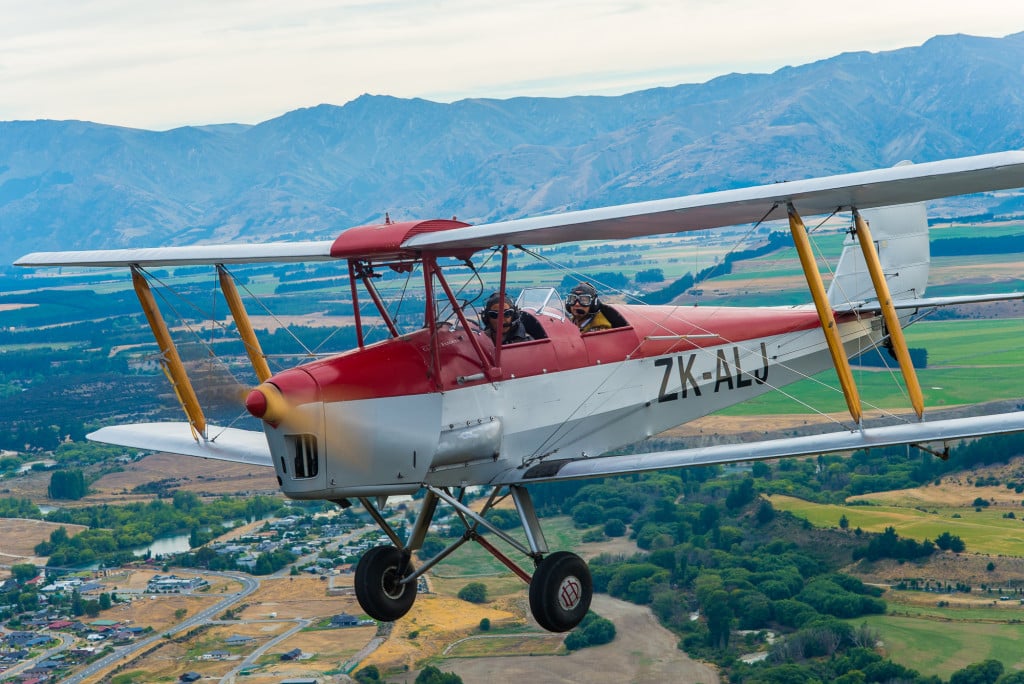
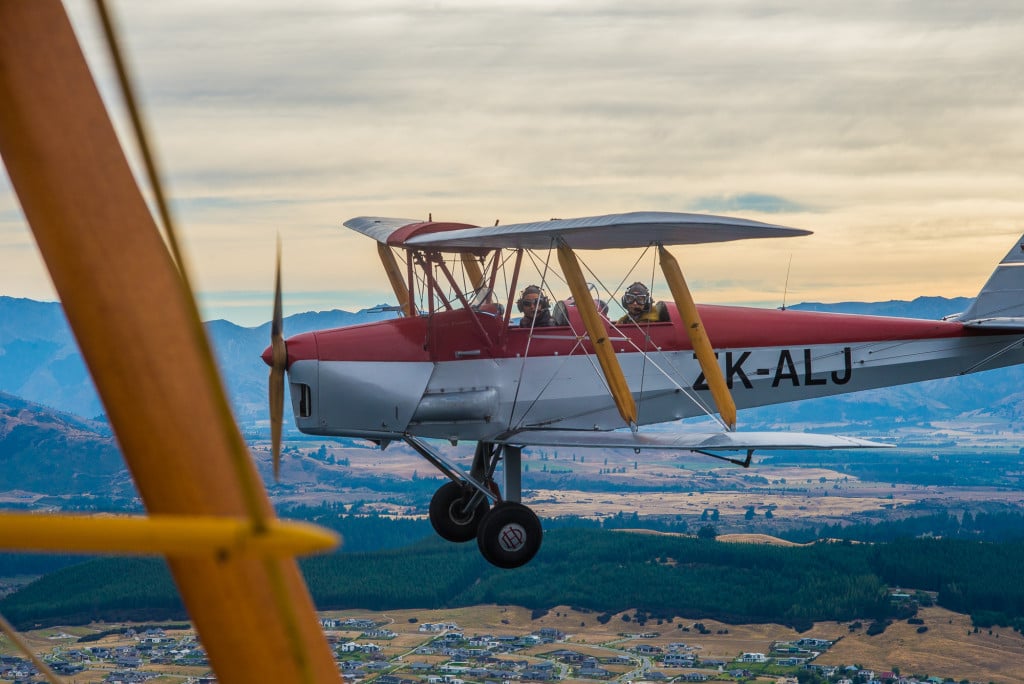
You can’t tell, but I am smiling!
We climbed away from land, the rush of wind teasing the fabric and wooden wings making her give little leaps and jumps. And I mean little, barely a bump, but I felt every single nuance of wind, air, and shift of the controls a hundredfold. Every sense on high alert, I tasted the sky as ALJ climbed. Flying in a Tiger Moth, an open cockpit biplane, is like riding a motorbike. The difference between their closed-cockpit counterparts is huge. Like cars, closed cockpit planes seal you off from the elements, they give an impression of security and detachment, and limit your experience of what’s around you. On a motorbike, or indeed in a Tiger Moth, you are part of the air. You can reach out and touch it, feel it beating through your outspread fingers as if through feathers on a wing. Your breath is full of pure sky, you can’t imagine! It’s like breathing new. Like breathing the first breath of a newborn baby.
And the sound of the wind dashing by, of the engine purring like a giant cat, together a symphony of freedom, a gorgeous roar of joy. And what you can see? Everything!
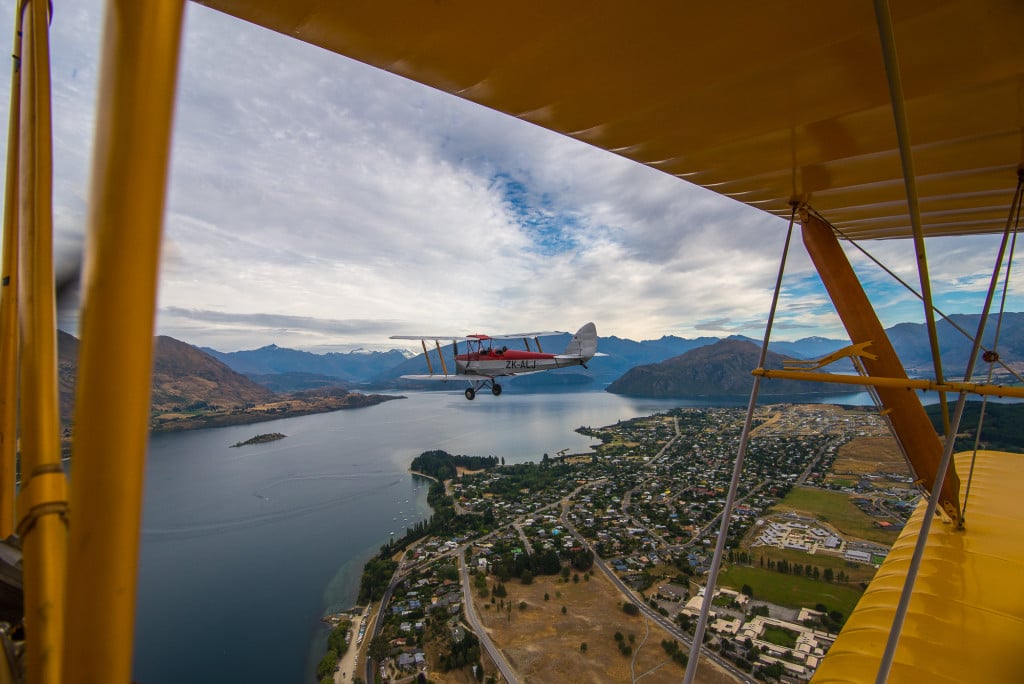
Flying over Eely Point in Wanaka, heading out over Lake Wanaka.
Pete instructed me to head towards Mount Iron, a hulking glacier-formed landmark; keep the nose up – but not too much, wings level, and keep a light touch on the stick and rudders as Tigers need a constant hand to fly. Unlike other aircraft, a Tiger Moth won’t just fly herself – she needs you as much as you need her. They like a firm hand, but a gentle hand. No need to grip the stick like a lollipop your brothers trying to steal. Treat her right and a Tiger will fly you to heaven and back.
We flew past Mount Iron, over the lakefront town of Wanaka, all quaint and quiet from up here, and I imagined my friends and family somewhere down there carrying on ordering coffees, doing lessons at school, typing up some document at work, and I whispered my gratitude to Pete at Classic Flights for this amazing experience. “Okay, Carla, we’re going to do some real flying now,” Pete’s voice, in answer to my silent thanks, crackled through my headset. Real flying? I thought I was!
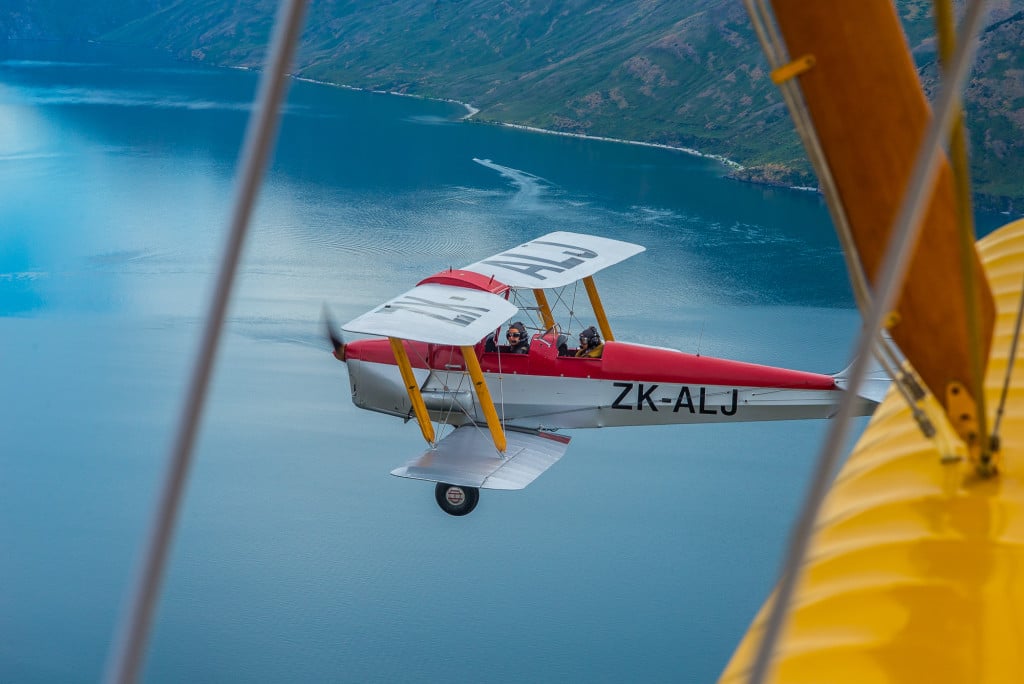
Real flying turned out to be turns. And waggling the wings. Oh, and an exciting little test of letting go of all controls to see what would happen. Yes, Tigers need to be flown. Absolutely. Otherwise they fall, gracefully true, but still fall out of the sky. Using the ailerons on the lower wings and the rudder bars at my feet, and playing with the stick that controls left and right roll, Pete taught me some simple, yet vital, flying manoeuvres. Tiger Moths are known for being easy to fly but hard to fly well. Pete and his pilots at Classic Flights fly these darlings of the sky like Fred Astaire dancing Ginger Rogers across the stage. And yet it was hard not to feel like an expert under Pete’s guidance. He explained how to manage ailerons, and rudder to combat adverse yaw. Yes, I just used those words! Did I know what they meant at the time? No! But did that matter? Not really! I was flying! Genuinely flying. And I loved every minute.
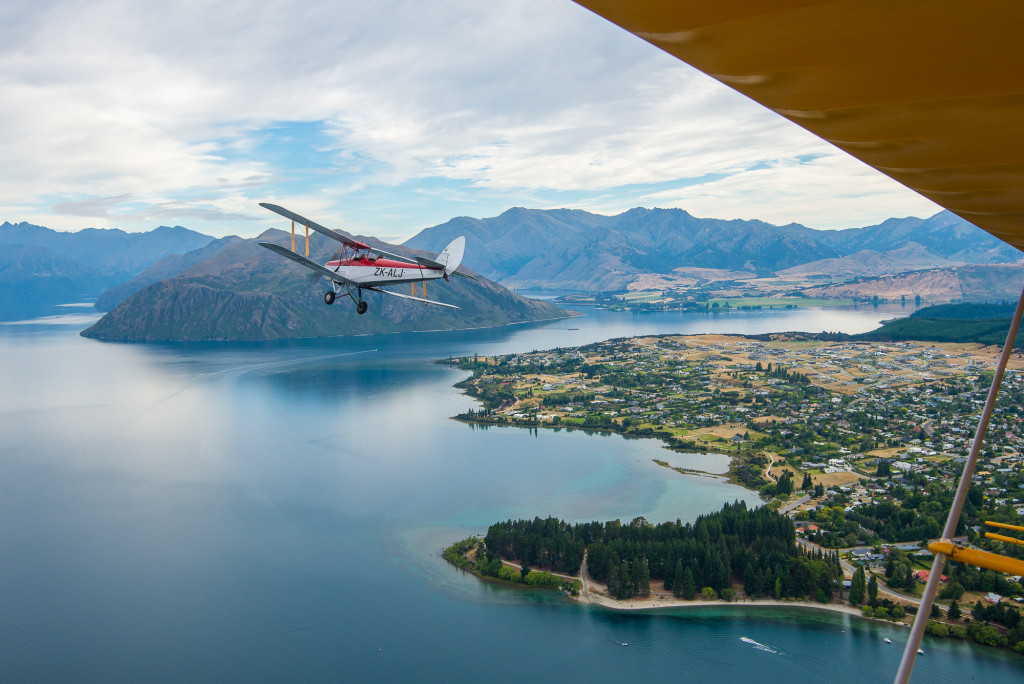
Making a perfect turn!
We all know the saying, what goes up must come down, and it came time to head back. We did a sweeping turn to the right of Stevenson’s Arm and followed the mighty turquoise serpent of the Clutha River back to Wanaka Airport. Landing. Probably the most difficult aspect of flying to get right. And the most important to get right – for here there be land. And land can be rather unforgiving on a fabric and wooden craft hitting it at 60 knots. For my first time I was more than happy to give Pete the controls while mimicking his every move on my own. I felt him throttle down, my fingers tracing every move he made as he powered down; the stick pushed forward to regulate the speed. Letting an aeroplane get too slow on finals, it will fall out of the sky – line it up, bring it to the centre line of the designated runway, ease back to flare, feel for the ground and slowly close the throttle all the way off. Touch left and right on the rudder to stop the crafts natural inclination to dance in a circle. The front two wheels, or the mains touch first, easing forward on the stick to keep the tail up, slowing down, and the tail gently drops to the ground. Then pull back on the stick to keep the tail down, using the rudder bars gently to keep it straight.
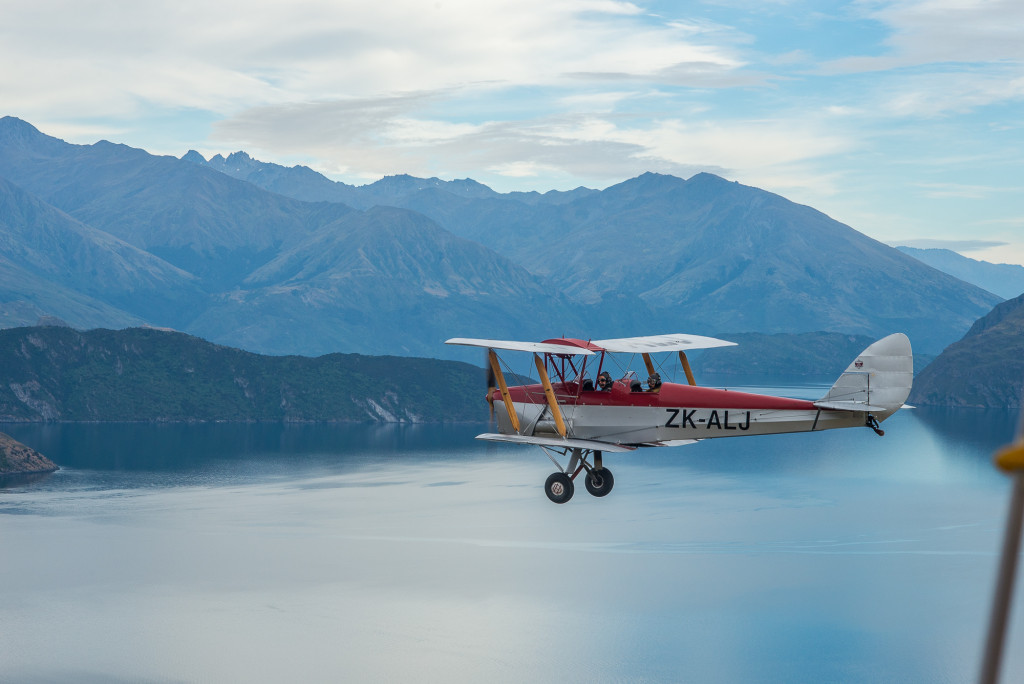
Finally – touch down! Rolling across the smooth grass of runway 29, crossing the tarmac and guiding ALJ home, it all happened so quickly and effortlessly. Before I knew it I was climbing down and patting her red and silver side. The grin on my face said it all as Pete asked what I thought of my first lesson. Maintaining an outward appearance of happy calm, I said I loved it. I said I couldn’t wait to do it again. I said I was hooked. All true. What I kept to myself was my tears of absolute bliss. I kept close to my heart the intense emotion that welled up inside, that made me want to scream ecstatically, leap about ALJ in a dance of love and gratitude. I kept to myself the secret I will let you in on now – flying is terrifying! But flying a plane has made me feel more alive than anything else I’ve ever done. And truly, I cannot wait for my next lesson!
Looking for something fun to do once you come down to earth? How about kayaking in Lake Wanaka?
Find more incredible activities and inspiration for your Lake Wanaka trip on their website, Facebook, Instagram, and Twitter.
All photos courtesy of Johan Lolos (LeBackpacker). Follow him on Instagram, Facebook, and his website.
